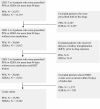Long-term use of proton pump inhibitors was associated with rapid progression to end stage kidney disease in a Korean nationwide study
- PMID: 39733180
- PMCID: PMC11682415
- DOI: 10.1038/s41598-024-83321-7
Long-term use of proton pump inhibitors was associated with rapid progression to end stage kidney disease in a Korean nationwide study
Abstract
Proton pump inhibitors (PPIs) are among the most widely used drugs worldwide. However, their influence on the progression of end-stage kidney disease (ESKD) in established chronic kidney disease (CKD) cases is unclear. Using the Korean Health Insurance Review and Assessment database encoded by the Observational Medical Outcomes Partnership-Common Data Model (OMOP-CDM), patients with stage 3 or 4 CKD initiating PPIs or histamine-2 receptor antagonists (H2RAs) for over 90 days were enrolled from 2012 through 2021. Incidence of ESKD events between the groups were compared using a cox proportional hazard model. A total of 34,656 eligible patients were included. Of the patients, 65.1% had CKD stage 3, 44.5% aged > 75 years, 59.8% were male individuals, and 68.3% had diabetes. After 1:1 propensity score matching, ESKD progression was observed in 2327 out of 19,438 patients and it was more frequent in PPI users (incidence rate, 10.5/100PYs) than that in H2RA users (incidence rate, 9.2/100PYs; IRR, 1.14 [1.07-1.12]). Using the subgroup analysis, IRR was significantly higher in patients with CKD stage 3 (IRR 1.40 [1.21-1.60]), whereas it was not in those with CKD stage 4 (IRR 1.04 [0.94-1.15]). A similar trend was observed in patients with CKD 3 or 4 with and without diabetes. In general, PPI use is associated with a 14% higher risk of ESKD progression in patients with CKD stage 3 or 4. However, the influence of PPIs differed according to the comorbidities and risks of adverse kidney outcomes.
Keywords: Chronic kidney disease; End stage kidney disease; Follow-up studies; Incidence; Proton pump inhibitors.
© 2024. The Author(s).
Conflict of interest statement
Declarations. Competing interests: The authors declare no competing interests. Ethics approval and consent to participate: Approval to perform the analyses was obtained with a waiver of informed consent from the Pusan National University IRB Committee [PNUH IRB 2308-021-130].
Figures




Similar articles
-
Accelerated risk of renal disease progression in pre-ESRD patients with proton pump inhibitors use: a nationwide population-based study.BMC Nephrol. 2024 Dec 23;25(1):469. doi: 10.1186/s12882-024-03867-6. BMC Nephrol. 2024. PMID: 39716090 Free PMC article.
-
Proton-pump inhibitor vs. H2-receptor blocker use and overall risk of CKD progression.BMC Nephrol. 2021 Jul 15;22(1):264. doi: 10.1186/s12882-021-02449-0. BMC Nephrol. 2021. PMID: 34266395 Free PMC article.
-
Non-indicated initiation of proton pump inhibitor and risk of adverse outcomes in patients with underlying chronic kidney disease: a nationwide, retrospective, cohort study.BMJ Open. 2024 Jan 29;14(1):e078032. doi: 10.1136/bmjopen-2023-078032. BMJ Open. 2024. PMID: 38286693 Free PMC article.
-
Associations of Proton-Pump Inhibitors and H2 Receptor Antagonists with Chronic Kidney Disease: A Meta-Analysis.Dig Dis Sci. 2017 Oct;62(10):2821-2827. doi: 10.1007/s10620-017-4725-5. Epub 2017 Aug 23. Dig Dis Sci. 2017. PMID: 28836158 Review.
-
The use of anti-ulcer agents and the risk of chronic kidney disease: a meta-analysis.Int Urol Nephrol. 2018 Oct;50(10):1835-1843. doi: 10.1007/s11255-018-1908-8. Epub 2018 Jun 13. Int Urol Nephrol. 2018. PMID: 29948864
References
-
- NICE Guideline cg184. 2019 Surveillance of Gastro-Oesophageal Reflux Disease and Dyspepsia in Adults: Investigation and Management (2019). - PubMed
-
- Statista. Leading chemical substances dispensed in England in 2022. https://www.statista.com/statistics/378445/prescription-cost-analysis-to....
-
- ClinCalc, L. L. C. Drug usage statistics, United States (2013–2021). https://clincalc.com/DrugStats/Drugs/Omeprazole.
-
- Oh, J.-A., Lee, G.-M., Chung, S.-Y., Cho, Y.-S. & Lee, H.-J. Utilization trends of proton pump inhibitors in South Korea: Analysis using 2016–2020 Healthcare Bigdata Hub by Health Insurance Review and Assessment Service. Yakhak Hoeji65, 276–283 (2021).
Publication types
MeSH terms
Substances
Grants and funding
LinkOut - more resources
Full Text Sources
Medical
Miscellaneous

